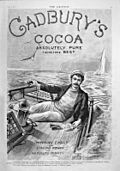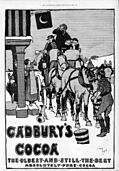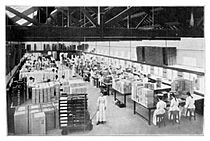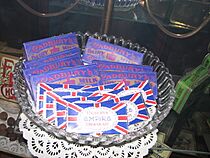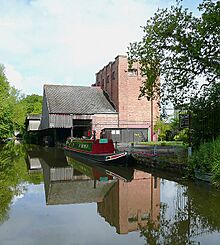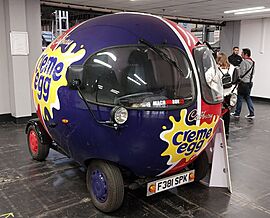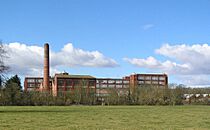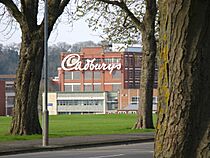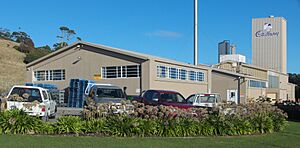Cadbury facts for kids
 |
|
| Subsidiary | |
| Traded as | LSE: CBRY (until 2010) |
| Industry | Confectionery |
| Founded | 4 March 1824 in Birmingham, England. |
| Founder | John Cadbury |
| Headquarters | Uxbridge Business Park, Greater London, England |
|
Key people
|
Dirk Van de Put (chairman and CEO) |
| Brands | List of Cadbury brands |
| Parent | Mondelez International |
Cadbury is a very famous British chocolate company. It is now owned by a company called Mondelez International. Cadbury is one of the biggest chocolate brands in the world, known for its delicious Dairy Milk chocolate, Creme Eggs, and Roses chocolate boxes. It has its main office in Greater London, England, and sells its products in over 50 countries. Many people in Britain think Cadbury is one of their most successful companies.
Cadbury was started in 1824 in Birmingham, England, by John Cadbury. He was a Quaker, which is a type of Christian group. John first sold tea, coffee, and drinking chocolate. He built the business with his brother Benjamin, and later his sons Richard and George took over. George Cadbury even created a special village called Bournville for the company's workers. This village had good homes and living conditions.
In 1905, George Cadbury Jr. introduced the Dairy Milk chocolate bar. It had more milk than other chocolates at the time. By 1914, it was Cadbury's most popular product. The company has continued to invent new and exciting chocolate treats over the years. Cadbury, along with Rowntree's and Fry's, were the three main chocolate makers in Britain for a long time.
Cadbury was given a special honour called a royal warrant by Queen Victoria in 1854. This meant they were official suppliers to the Royal Family. They held this honour from Elizabeth II from 1955 until 2022. Cadbury joined with another company called J. S. Fry & Sons in 1919. Later, in 1969, they merged with a drinks company called Schweppes, and the company was known as Cadbury Schweppes until 2008.
Contents
History of Cadbury
Early Years: 1800s
On 4 March 1824, John Cadbury, a Quaker, started his business in Birmingham, England. He sold tea, coffee, and drinking chocolate. By 1831, he began making different types of cocoa and drinking chocolates in a factory. These were mostly sold to rich people because they were expensive to make. In 1842, he started selling chocolate that people could eat.
In 1847, John Cadbury worked with his brother Benjamin, and the company became "Cadbury Brothers." Around this time, another company, Fry's, made the first chocolate bar. Cadbury then made its own chocolate bar in 1849. In 1854, Cadbury received a special honour from Queen Victoria, making them official chocolate makers for the Royal Family. However, the company faced difficulties in the late 1850s.
John Cadbury's sons, Richard and George, took over the business in 1861. The company was struggling, with only 11 employees left. But the brothers worked hard, focusing on chocolate and making their products better. By 1866, Cadbury was making money again.

A big step forward happened in 1866 when Richard and George brought an improved cocoa to Britain. They used a new machine from the Netherlands that made cocoa taste better. Cadbury started selling its products to other countries in the 1850s. In 1861, they created "Fancy Boxes" of chocolates. In 1868, they sold heart-shaped boxes for Valentine's Day, which quickly became a popular gift for the holiday.
Cadbury made its first Easter egg in 1875. They found a way to mould pure cocoa butter into smooth shapes, creating the modern chocolate Easter egg. By 1893, Cadbury had 19 different kinds of chocolate Easter eggs.
In 1878, the brothers decided to build a new factory outside Birmingham. They chose a place called Bournbrook, which they renamed Bournville. It was a good spot because it was easy to get milk by canal and cocoa by train. The Bournville factory opened in 1879. In 1891, the Cadbury brothers created a special recipe for a chocolate-covered biscuit.
In 1893, George Cadbury bought a large area of land near the factory. He wanted to build a "model village" for his workers, with better homes and living conditions. By 1900, the village had 314 houses and cottages. Because the Cadbury family were Quakers, there were no pubs in the village.
In 1897, Cadbury started making its own milk chocolate bars, following the lead of Swiss companies. In 1899, Cadbury became a proper company with shares.
Growth and Changes: 1900–1969
In 1905, Cadbury launched its famous Dairy Milk bar. It was a high-quality chocolate with more milk than other bars. George Cadbury Jr. and his team developed it. It was the first time a British company could make milk chocolate in large amounts. From the start, it had its special purple wrapper. It quickly became very popular and was the company's best-selling product by 1914.
Cadbury's Milk Tray chocolates were first made in 1915. During World War I, over 2,000 Cadbury male employees joined the army. Cadbury helped the war effort by giving chocolate, books, and clothes to the soldiers. George Cadbury even let two company buildings be used as hospitals. After the war, the Bournville factory was updated for mass production. In 1918, Cadbury opened its first factory outside the UK in Hobart, Tasmania, Australia.
In 1919, Cadbury joined with Fry's, adding popular chocolates like Fry's Chocolate Cream to their range. Many small Fry's factories closed, and production moved to a new factory near Bristol.
Cadbury kept adding new products: Flake (1920), Creme Eggs (1923), Fruit and Nut (1928), and Crunchie (1929). By 1930, Cadbury was one of the largest manufacturing companies in Britain. Roses chocolates were introduced in 1938 and became a very popular gift, especially at Christmas.
By the mid-1930s, most people in Britain could afford chocolate. By 1936, Dairy Milk made up 60% of the UK milk chocolate market. Between the two world wars, Cadbury sent chocolate samples to British schoolchildren for their opinions. One of these children was Roald Dahl, who later wrote the famous book Charlie and the Chocolate Factory.
During World War II, parts of the Bournville factory made things for the war, like parts for fighter planes. Workers even grew crops on football fields. Chocolate was seen as an important food, so the government controlled it during the war. Chocolate rationing ended in 1950, and normal production started again. Cadbury then built new factories because more people wanted their products.
In 1967, Cadbury bought an Australian chocolate company called MacRobertson's. This helped Cadbury gain a 60% share of the Australian chocolate market.
Joining with Schweppes: 1969
Cadbury merged with the drinks company Schweppes in 1969, forming Cadbury Schweppes. This merger changed Cadbury's long-standing connection to its Quaker founding family.
In 1978, the company bought Peter Paul, a large chocolate maker in the United States. This gave Cadbury a 10% share of the US chocolate market. The popular Wispa chocolate bar was launched in 1981. By 1982, Cadbury was making more money outside Britain than inside.
In 1986, Cadbury Schweppes sold its drinks and food parts to a new company called Premier Brands. This meant Cadbury no longer owned brands like Typhoo Tea or Kenco coffee.

In 1992, Sir Adrian Cadbury, who was the company's chairman, created the Cadbury Report. This was a set of good rules for how companies should be run, and it helped improve company management around the world. In the 1990s, Cadbury Schweppes bought several drink companies, becoming one of the biggest soft drink makers globally. However, in 1999, they sold most of their drink businesses to The Coca-Cola Company.
In 2003, Cadbury Schweppes bought Adams, a chewing gum company, for a lot of money. This made Cadbury the biggest confectionery company in the world at that time. In 2005, they bought Green & Black's, a company known for its organic chocolate.
Splitting from Schweppes
In 2007, Cadbury Schweppes announced it would split into two separate companies. One would focus on chocolate and sweets, and the other on its US drinks business. This split happened on 2 May 2008. The drinks business became Dr Pepper Snapple Group, and the chocolate company became Cadbury plc.
Recent Years: 2007–2024
In October 2007, Cadbury said it would close its Somerdale Factory in England. Production moved to other factories in England and Poland.
In 2009, Cadbury changed some of its chocolate recipes outside the UK, using palm oil instead of cocoa butter. Many people in Australia and New Zealand were unhappy about this, both because of the taste and because palm oil production can harm rainforests. By August 2009, Cadbury announced it would go back to using cocoa butter in New Zealand and Australia. They also said they would get cocoa beans through Fair Trade channels, which helps farmers.
Becoming Part of Mondelez
On 7 September 2009, a big American food company called Kraft Foods offered to buy Cadbury. Cadbury said the offer was too low. Kraft then made a formal offer on 9 November 2009.
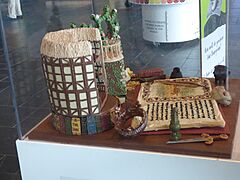
On 19 January 2010, Cadbury and Kraft Foods agreed on a deal. Kraft bought Cadbury for a large sum of money. Kraft said this deal would create a "global confectionery leader." Many people in Britain were unhappy about the takeover, including the public and trade unions. They worried about job losses.
On 2 February 2010, Kraft officially took over Cadbury. On 9 February, Kraft announced it would close the Somerdale Factory, leading to job losses. This upset many staff members.
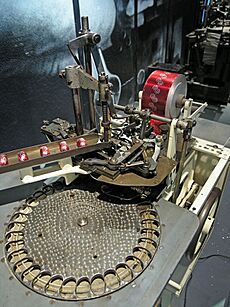
In 2011, Kraft Foods announced it would split into two companies. On 1 October 2012, the snack and chocolate part of Kraft became Mondelez International, and Cadbury became part of Mondelez.
Since 2015, Mondelez has closed some Cadbury factories in countries like Ireland, Canada, and New Zealand. They moved production to other countries like China and India. This caused protests in the places where factories closed.
In January 2017, Cadbury became the official snack partner of the Premier League in football.
200th Anniversary
On 8 January 2024, Mondelez International announced plans to celebrate Cadbury's 200th anniversary. This included special promotions and seven old-style packaging designs for its Dairy Milk bars.
On 23 December 2024, it was announced that Cadbury would no longer hold its Royal Warrant from King Charles III. Cadbury had held a royal warrant for 170 years, since the time of Queen Victoria. The reason was not officially given, but groups had asked the King to remove warrants from companies that still operate in Russia. Mondelez International, Cadbury's owner, still operates there.
Where Cadbury Operates
Head Office
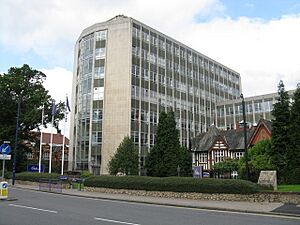
Cadbury's main office is in Cadbury House in Uxbridge, Greater London, England. It shares this office with Mondelez's UK division.
Production Sites
Bournville
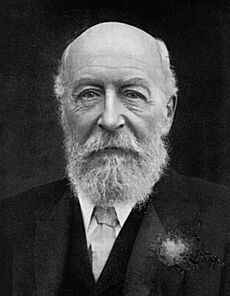
The Cadbury factory in Bournville, England, opened in 1879. It was started by George Cadbury, who wanted one-tenth of the area to be parks and open spaces. It became known as "the factory in a garden." Cadbury's dark chocolate bar, Bournville, is named after this special village.
Almost 1,000 people work at Bournville. In 2014, Mondelez invested a lot of money in the site, showing that Bournville is still very important to the British chocolate industry. Bournville is also where Mondelez does its main research and development for new chocolate products. Every new Cadbury chocolate starts there.
United Kingdom
In the UK, the chocolate business is called Cadbury. It has several factories and many staff. Mondelez also sells biscuits with the Cadbury brand, like Cadbury Fingers. They also own other sweet brands like Fry's and Maynards Bassetts.
Ice cream made with Cadbury products, like 99 Flake, is made by another company under a special agreement. Cadbury cakes and chocolate spread are also made by another company.
In 2013, Cadbury chocolate wrappers were among the most common types of rubbish found on UK streets. In 2014, Cadbury Dairy Milk was the best-selling chocolate bar in the UK.
Ireland
Cadbury Ireland Cadbury Ireland Limited has its main office in Coolock, Dublin, and another factory in Rathmore, County Kerry. They make products like Cadbury Dairy Milk, Cadbury Twirl, Flake, and Boost.
United States
 |
|
| Subsidiary | |
| Founded | December 2002 |
| Headquarters |
,
U.S.
|
| Products | Cadbury Creme Egg, Cadbury Dairy Milk, Mini Eggs |
| Brands | Hershey (licensee) |
| Owners | Mondelez International |
| Parent | Cadbury plc |
Cadbury USA makes candy, gum, breath mints, and cough drops. Its main office is in Parsippany, New Jersey. This company was formed when Cadbury Schweppes bought the Adams brand in 2002.
In 1988, The Hershey Company bought the rights to make and sell Cadbury chocolate products in the US. So, even though Cadbury chocolate is sold in the US, it is made by Hershey. Some customers say the Hershey-made products taste different from the original ones.
Cadbury USA's products include:
Maynards
- Wine Gums
- Swedish Fish
- Swedish Berries
- Juicy Squirts
- Original Gummies
- Fuzzy Peach
- Sour Chillers
- Sour Patch Kids
- Mini Fruit Gums
- Sour Cherry Blasters
- Fruit Mania
- Bassett's Liquorice Allsorts
Chocolate-related
- Creme egg
- Caramello
- Royal Dark
- Dairy Milk
Gum
- Black Jack chewing gum
- Bubbaloo bubble gum
- Bubblicious bubble gum
- Chiclets
- Clorets
- Dentyne
- Freshen Up Gum
- Sour Cherry Gum
- Sour Apple Gum
- Stride
- Trident
Other
- Certs breath mints
- Halls (cough drop)
Australia
Cadbury products first came to Australia in 1853. Cadbury's first order from outside the UK in 1881 was for Australia. In 1919, the company decided to build a factory in Australia. They chose Tasmania because it was near Hobart, had cheap electricity, and lots of fresh milk. Cadbury's Claremont factory was built like the Bournville factory, with its own village and sports areas.
The first products from Claremont were sold in 1922. Cadbury's Claremont used to be a popular place for tourists, offering daily tours. However, tours stopped in 2008 for safety reasons. Cadbury's Claremont is the largest chocolate factory in the Southern Hemisphere. Cadbury also has a milk-processing plant in Cooee, Tasmania and two other factories in Melbourne, Victoria.
In 2015, the Cadbury factory in Hobart reduced its staff. In 2017, its visitor centre closed.
New Zealand
Cadbury also had a factory in Dunedin, New Zealand, until it closed in March 2018. In 1930, Cadbury worked with a local businessman named Richard Hudson. His factory became Cadbury Hudson. Cadbury later opened another factory in Auckland. In 2003, Cadbury opened a tourist attraction called Cadbury World at the Dunedin factory, which had a big chocolate waterfall. In 2007, Cadbury closed its Auckland factory, meaning 200 people lost their jobs.
In 2009, the Cadbury Dunedin factory faced criticism for using palm oil instead of cocoa butter. The company changed back but still used palm oil in some fillings. Over the next few years, Cadbury started making its chocolate blocks smaller.
On 16 February 2017, it was announced that Cadbury would close its Dunedin factory by March 2018, affecting 350 jobs. Mondelez said the closure was because they wanted to move chocolate making to Cadbury's Australian factories. However, Dunedin's Cadbury World tourist attraction stayed open because it was so popular.
After talks with employees and local leaders, the closure went ahead. Mondelez offered support to staff and even sponsored some to move to Australia for work. Mondelez also looked for other companies to keep making popular New Zealand Cadbury brands like Pineapple Lumps and Jaffas.
On 17 October 2017, Cadbury said it would move all production of its New Zealand brands to Australia. This happened in March 2018. Mondelez explained that making Cadbury products needed special machines and skills that local New Zealand companies did not have.
In May 2023, it was reported that the Dunedin Cadbury World would close. The Ministry of Health bought the old factory site to build a new hospital.
Canada
Cadbury's Canadian head office is in Toronto. Cadbury Canada makes and imports many products under the Cadbury and Maynards names, including:
|
|
Cadbury Canada is now part of Mondelez Canada.
India
| Industry | Manufacture of cocoa, chocolate and sugar confectionery |
|---|---|
| Founded | 19 July 1948 |
| Headquarters | Mumbai, India |
|
Key people
|
Anand Kripalu, managing director |
| Products | Cadbury Dairy Milk, 5-star, Perk, Gems, Eclairs, Oreo and Bournvita |
|
Number of employees
|
2000 |
Cadbury India started in 1948 by bringing chocolates into India. It now has factories in several places like Thane and Hyderabad, and offices in big cities like New Delhi and Mumbai. Since 1965, Cadbury has also helped grow cocoa plants in India. They have worked with the Kerala Agricultural University to research cocoa for over 20 years.
Cadbury India sells chocolate, drinks, biscuits, gum, and candy. Its products include Cadbury Dairy Milk, Dairy Milk Silk, Bournville, Temptations, Perk, Eclairs, Bournvita, and Oreo.
It is the biggest chocolate company in India, with over 70% of the market. On 21 April 2014, Cadbury India changed its name to Mondelez India Foods Limited.
South Africa
Cadbury came to South Africa in 1903. The Cadbury brothers hired someone to sell their products there. The brand became so popular that in 1926, Cadbury South Africa was formed, and they planned to build a chocolate factory.
The chocolate factory in Port Elizabeth started being built in 1930. By 1938, the first Cadbury Dairy Milk chocolate bars were made there. The factory expanded in the 1950s to make new products like Flake and Crunchie Bar. This factory still makes some of the Cadbury chocolate sold in South Africa.
In 2011, Kraft Foods, which owned Cadbury at the time, launched a Fair Trade Dairy Milk chocolate bar in South Africa. Cadbury's operations in South Africa get their cocoa beans from Ghana, and the chocolate bars are made in the Port Elizabeth factory.
Advertising Cadbury
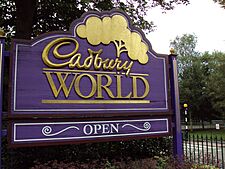
The Cadbury logo, which looks like a signature, comes from the signature of William Cadbury, the founder's grandson, in 1921. It became the worldwide logo in the 1970s. Cadbury chose purple as its company colour in 1905 to honour Queen Victoria, who had passed away four years earlier. Cadbury famously registered purple as its special colour for chocolates.
In 1928, Cadbury's started using the "glass and a half" slogan for Cadbury Dairy Milk. This showed that the bar had a lot of milk. The Creme Egg slogan, "How do you eat yours?", started in 1985. Cadbury has also used fun campaigns, like a Double Decker bus and pop-up cafes. They have even had famous names on their products, like Paddington Bear and the Spice Girls.
Many Cadbury commercials have been very popular in Britain. The 2007 Gorilla TV commercial for Cadbury Dairy Milk, which featured the song "In the Air Tonight", won many awards.
Every year, Cadbury also runs a Secret Santa campaign. They encourage people to secretly give a free chocolate bar to their loved ones.
Cadbury Products
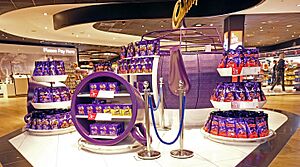

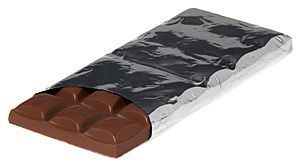
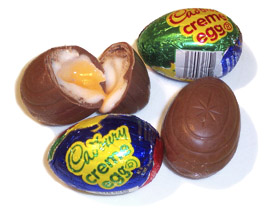
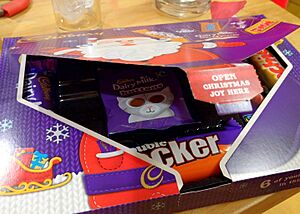
Some of the main chocolate bars made by Cadbury include Dairy Milk, Crunchie, Double Decker, Caramel, Wispa, Boost, Picnic, Flake, Curly Wurly, Chomp, and Fudge. They also make chocolate Buttons, the boxed chocolate brand Milk Tray, and the twist-wrapped chocolates Heroes, which are popular around holidays like Christmas and Halloween.
Selection boxes (with a mix of Cadbury bars and sweets) are a traditional Christmas gift in Britain. Cadbury Roses have also been a popular gift since the late 1930s. Creme Eggs are only sold between New Year's Day and Easter. They are the most popular chocolate in the UK during this time.
Besides chocolate, Cadbury also owns Maynards and Halls. They are linked to other sweets like Liquorice Allsorts, Jelly Babies, Mints, Black Jack chews, and Trident gum.
Some important products introduced over the years include:
- 1866: Cocoa Essence
- 1868: Heart-shaped box of chocolates (for Valentine's Day)
- 1875: Easter Eggs
- 1897: Milk Chocolate and Fingers
- 1905: Dairy Milk
- 1908: Bournville
- 1914: Fry's Turkish Delight
- 1915: Milk Tray
- 1920: Flake
- 1923: Creme Egg
- 1926: Cadbury Dairy Milk Fruit & Nut
- 1929: Crunchie
- 1938: Roses
- 1948: Fudge
- 1958: Picnic
- 1960: Dairy Milk Buttons
- 1965: Cadbury Eclairs
- 1967: Mini Eggs
- 1969: Cadbury 5 Star
- 1970: Curly Wurly
- 1976: Double Decker
- 1981: Wispa
- 1985: Boost
- 1987: Twirl
- 1999: Heroes
- 2001: Dream
- 2004: Cadbury Chocolate Digestives
- 2009: Dairy Milk Silk
- 2012: Marvellous Creations
- 2021: Cadbury Plant Bar (vegan)
Important Events
2006 Salmonella Scare
In January 2006, Cadbury found a type of bacteria called Salmonella in some of its products. This happened because of a leaking pipe at a factory. Cadbury recalled over a million chocolate bars to keep people safe. The company was later fined for not telling the authorities about the problem sooner.
2007 Recalls
In February 2007, Cadbury recalled some Easter eggs because the labels did not clearly say they were made in a factory that also handled nuts. This was to protect people with nut allergies. Cadbury said the chocolates were safe for everyone else.
Later in September 2007, Cadbury recalled more chocolate bars because of another printing mistake. Some labels were missing warnings about tree nuts.
2008 Contamination in China
In September 2008, Cadbury removed all 11 of its chocolate products made in its factories in Beijing, China. This was because of concerns about contamination. The recall affected China, Taiwan, Hong Kong, and Australia.
2014 Pork Traces in Malaysia
Cadbury recalled two chocolate products in Malaysia after tests showed possible traces of pork DNA. This was found during regular checks for non-halal ingredients. However, after new tests, Malaysia's Department of Islamic Development (JAKIM) announced that the samples did not contain pig DNA.
2017 "Easter" Discussion
In 2017, some people were unhappy that Cadbury and the National Trust called their annual "Easter Egg Trails" "Cadbury Egg Hunts." The Prime Minister of the United Kingdom, Theresa May, called it "absolutely ridiculous." However, Cadbury said that the word "Easter" was clearly used in their advertising materials. A similar discussion happened in Australia about the word "Easter" on chocolate egg packaging.
2019 "Cadbury Treasures" Campaign
Before Easter 2019, Cadbury launched a "Treasures" promotion. It encouraged people to look for treasure, but it accidentally led some to illegally dig at protected historical sites. This caused archaeologists to be very critical of the campaign.
2022 Child Labour Claims
In 2022, a TV show called Cadbury Exposed: Dispatches claimed that child labour was used in cocoa farming for Cadbury chocolate. Mondelez International said they were very concerned and would investigate the claims.
2023 Listeria Recall
In May 2023, Muller recalled six Cadbury desserts as a safety step. This was because there was a chance they might contain listeria bacteria.
Fun Facts About Cadbury
- Cadbury made its first Easter egg in 1875. They created the modern chocolate Easter egg by finding a way to mould pure cocoa butter into smooth shapes.
- In 1861, the company started making "Fancy Boxes" – decorated boxes of chocolates. In 1868, they sold chocolates in heart-shaped boxes for Valentine's Day.
- Cadbury opened its first factory outside the UK in 1918. It was in Hobart, Tasmania, Australia.
- Between the two World Wars, Cadbury sent chocolate samples to British schoolchildren. They asked for their opinions on new products. One of these children was Roald Dahl, who later wrote the famous book Charlie and the Chocolate Factory!
- In January 2017, Cadbury became the official snack partner of the Premier League football league. They sponsored awards like the Premier League Golden Boot.
- The swirly Cadbury logo comes from the signature of William Adlington Barrow Cadbury. He was the founder's grandson, and his signature was used in 1921. It became the worldwide logo in the 1970s.
- The company chose purple as its main colour in 1905. This was to honour Queen Victoria, who had passed away four years earlier.
- Every year, Cadbury runs a "Secret Santa" campaign. It uses both online and offline advertisements.
Images for kids
See also
 In Spanish: Cadbury para niños
In Spanish: Cadbury para niños



